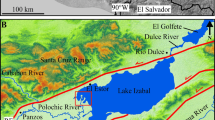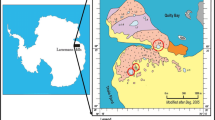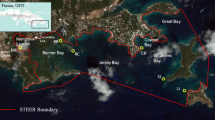Abstract
The Lake of Tunis in northern Tunisia is a eutrophic marine lagoon covering 45 km2 to an average depth of 1 m. Exchange of water with the Mediterranean Sea is restricted to a few canals. Bottom sediment is mainly calcareous sandy mud with much organic material. Sand-size grains commonly include quartz, dolomite, gypsum, and pyrite, as well as calcareous skeletal material dominated by molluscan fragments. Pyrite is the only important authigenic mineral presently forming. Principal sources of sediment are sewage sludge and fill, calcareous marine organisms, including abundant worm reefs, and local intermittent streams. The concentrations of Hg, Pb, Cd, Cr, Zn, Cu, and Fe are significantly higher in Lake of Tunis sediments than in sediments from Bahiret el Bibane, an unpolluted lagoon in the south of Tunisia.
Man has affected the Lake of Tunis in four important ways. (1) Cultivation by early settlers, particularly the Romans, caused increased regional erosion and probably provided the sediment that encloses the lagoon. (2) In the mid-1800's the French constructed a ship canal which reduced intralagoonal circulation as well as exchange with the Mediterranean. (3) Nutrient pollution from sewage has encouraged the growth of circulation-restricting worm reefs, caused eutrophication and fish kills, and produced H2S odor which permeates the city of Tunis during the summer. (4) Finally, man has significantly reduced the size of the lagoon by filling the lagoon and operating salt pans.
Similar content being viewed by others
References
Aston, S. R., 1974, Stream sediment composition, an aid to water quality assessment: Water, Air and Soil Pollution, v. 3, 29 p.
Ball, D. F., 1964, Loss on ignition as an estimate of organic matter and organic carbon in non-calcareous soil: Jour. Soil Sci., v. 15, p. 84–95.
Berner, R. A., 1971, Principles of chemical sedimentology: New York, McGraw Hill Book Co., 240 p.
Brogan, O., 1967, Roman Tunisia,in Guidebook to the geology and history of Tunisia: Libya Petroleum Exploration Soc. of Libya, 9th Ann. Fld. Conf. Guidebook p. 17–35.
Carroll, D., 1958, Role of clay minerals in transporting iron: Geochim. et Cosmochim. Acta, v. 14, p. 1–29.
Craig, L., 1967, Arab Tunisia,in Guidebook to the geology and history of Tunisia: Libya Petroleum Exploration Soc., 9th Ann. Fld. Conf. Guidebook p. 37–48.
Coque, J., and A. Jauzein, 1967, The geomorphology and Quaternary geology of Tunisia,in Guidebook to the geology and history of Tunisia: Libya Petroleum Exploration Soc., 9th Ann. Fld. Conf., Guidebook, p. 227–258.
Folk, R. L., 1968, Petrology of sedimentary rocks: Austin, Texas, Hemphills, 170 p.
Glennie, K. W., 1970, Desert sedimentary environments: New York, Elsevier Co; Developments in Sedimentation 14, 198 p.
Grim, R. E., 1965, Clay mineralogy: New York, McGraw Hill Book Co., 582 p.
Keer, F., 1975, Sediments of Bahiret el Bibane: Duke Univ., unpub. M.S. Thesis 85 p.
Kinsman, D. J. J., 1969, Modes of formation, sedimentary associations and diagnostic features of shallow-water and supratidal evaporites: Am. Assoc. Petroleum Geologists Bull., v. 53, p. 830–840.
Klein, D. H., 1075, Fluxes, residence times and sources of some elements to Lake Michigan: Water, Air and Soil Pollution, v. 4, p. 3–8.
Kronfeld, J., and J. Naurot, 1975, Aspects of trace metal contamination in the coastal rivers of Israel: Water, Air and Soil Pollution, v. 4, p. 127–134.
Levy, Y., 1974, Sedimentary reflections of deposition environment in the Bardawil Lagoon, Northern Sinai: Jour. Sed. Petrology, v. 44, p. 219–227.
Lucas, G., 1959, Deux exemples actuels de biolithosores construits par des Annelides: Bull. Soc. Géol. de France, v. 1, p. 385–389.
Mithis, B. J., and N. R. Kevern, 1973, Distribution of mercury, cadmium, lead, and thallium in a eutrophic lake: Michigan State Univ. Inst. Water Res., Tech. Rept. 34, 23 p.
Moore, H. B., 1955, Faecal pellets in relation to marine deposits,in Trask ed., (Marine Sediments) Soc. Econ. Paleon. and Min., Spec. Paper 4., p. 516–524.
Nelson, C. H., D. E. Pierce, K. W. Leong, and Frank F. Wang, 1975, Mercury distribution in ancient and modern sediment of Northeastern Bering Sea: Marine Geology, v. 18, p. 91–104.
Peres, J. M., 1967, The Mediterranean benthos: Oceanography and Marine Biology Annual Review, v. 5, p. 449–533.
Pimenta, J., 1959, Le cycle Pliocène-Actuel dans les bassins paraliques de Tunis: Société Géologique de France, Mem. no. 85, 27 p.
Shepard, F. P., 1973, Submarine geology: New York, Harper and Row, 3rd ed., 517 p.
Stirn, J., 1968a, The pollution of the Tunis Lake: Revue Internationale d'Océanographie Médicale, Tome IX, p. 99–106.
-- 1968b, The consequences of the increased sea bioproduction caused by organic pollution and possibilities for the protection: Rev. Intern. Oceanogr. Med., Tome X, p. 123–129.
-- 1971, Ecological Consequences of Marine Pollution: Rev. Intern. Oceanogr. Med., Tome XXIV, p. 13–46.
Warmington, B. H., 1967, Phoenician Carthage,in Guidebook to the geology and history of Tunisia: Libya Petroleum Exploration Soc., 9th Ann. Fld. Conf., Guidebook p. 5–16.
Watkins, J., and O. H. Pilkey, 1973, Le Sable des plages tunisiennes: Notes du Serv. Geol., no. 39, 41 p.
Wedman, E. J., 1964, Geohydrology of Sebkha Sedjoumi's (Tunisia): Internat. Assoc. Scientific Hydrology, pub. 64, 67 p.
Zaouali, J., 1971, Etude de l'écologie du Lac de Tunis et de la Mer de Bougrave (Tunisie), leurs peuplements malecologiques: L'Université de Caen, France, unpub. dissert., 254 p.
Author information
Authors and Affiliations
Rights and permissions
About this article
Cite this article
Harbridge, W., Pilkey, O.H., Whaling, P. et al. Sedimentation in the Lake of Tunis: A lagoon strongly influenced by man. Geo 1, 215–225 (1976). https://doi.org/10.1007/BF02407508
Received:
Revised:
Published:
Issue Date:
DOI: https://doi.org/10.1007/BF02407508




